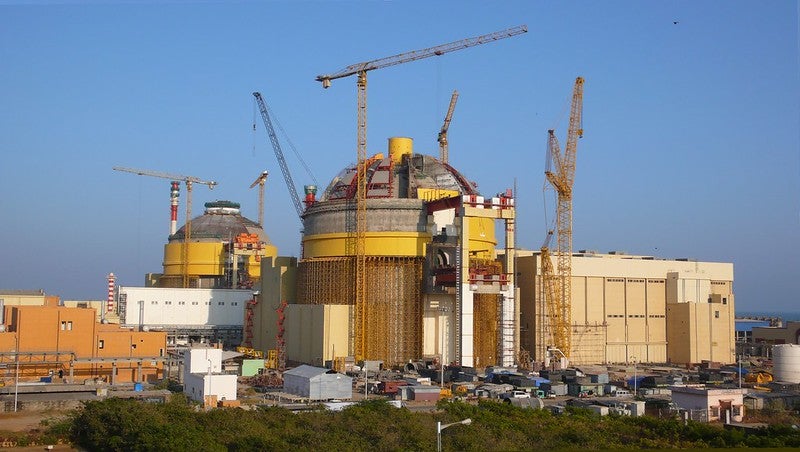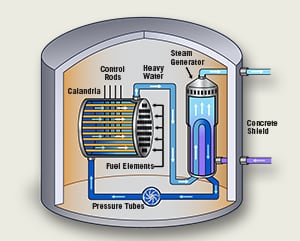KUNDANKULAM NUCLEAR POWER PLANT
- The Kudankulam project is the outcome of a bilateral agreement between India and Russia. It involves collaboration between the Nuclear Power Corporation of India Limited (NPCIL) and Russia's Rosatom State Atomic Energy Corporation
- The KKNPP has several VVER (Water-Water Energetic Reactor) pressurized water reactors, with each unit designed for electricity generation. As of the last update in 2022, Units 1 and 2 were operational, while Units 3 and 4 were under construction
- Each operational unit has a capacity of around 1,000 megawatts (MW). The plant aims to contribute significantly to India's electricity production, especially for the southern region
- The plant is equipped with advanced safety measures and technologies to ensure the safe operation of nuclear reactors, including redundant safety systems and international safety standards
- The project faced opposition and protests from local communities and activists concerned about the potential environmental impact, safety issues, and displacement of people due to the construction and operation of the plant
- The collaboration between India and Russia in the Kudankulam project holds geopolitical significance and represents a key aspect of bilateral cooperation in the field of nuclear energy

-
Nuclear Fission: This process involves the splitting of a heavy atomic nucleus, such as uranium-235 or plutonium-239, into smaller fragments when bombarded by neutrons. This reaction releases a significant amount of energy along with additional neutrons, which can further trigger more fission reactions, creating a chain reaction.
-
Nuclear Fusion: Fusion is the process of combining two light atomic nuclei, such as hydrogen isotopes (deuterium and tritium), to form a heavier nucleus. This process occurs at extremely high temperatures and pressures, like those found in the core of stars. Fusion reactions release tremendous amounts of energy and are the basis of the sun's energy production.
-
Electricity Generation: Nuclear reactors are designed to harness the heat generated by nuclear reactions to produce steam, which drives turbines and generates electricity. This process is used in nuclear power plants.
-
Diverse Applications: Apart from electricity generation, nuclear energy finds applications in various fields like medicine (radiation therapy and medical imaging), industry (sterilization, food preservation, and material testing), and space exploration (powering spacecraft and probes)
-
High Energy Density: Nuclear reactions release an immense amount of energy from relatively small amounts of nuclear fuel compared to other energy sources like fossil fuels.
-
Low Greenhouse Gas Emissions: Nuclear energy generation produces minimal greenhouse gas emissions during the electricity production process. However, there are considerations regarding emissions associated with uranium mining, reactor construction, and waste management.
- Reduced Greenhouse Gases: Nuclear power plants produce electricity without emitting greenhouse gases during the power generation process. This makes nuclear energy a valuable resource for combating climate change by offering a low-carbon alternative to fossil fuels
- Continuous Power Generation: Nuclear power provides a stable and consistent source of electricity that isn't affected by weather conditions. This reliability makes it a crucial component of the energy mix, especially in regions where renewable energy sources might be intermittent
- As global energy demand continues to rise, nuclear power can contribute significantly to meeting this demand, especially in densely populated areas or regions with high energy requirements
- Access to reliable and affordable electricity fosters economic growth and development, which nuclear energy can help support
- The nuclear energy sector drives innovation and technological advancements that can have broader applications beyond electricity generation, contributing to scientific progress
- Advancements in nuclear technology, such as smaller modular reactors (SMRs), hold the potential to provide localized power in remote areas or regions lacking access to centralized power grids
-
Moderation and Cooling: Heavy water serves as a moderator, slowing down the neutrons produced in the nuclear fission process, enabling them to efficiently cause additional fission reactions. Additionally, heavy water acts as a coolant, transferring heat away from the reactor core.
-
Fuel: PHWRs use natural uranium as fuel, which doesn’t require enrichment as it contains a higher percentage of uranium-238, the isotope suitable for sustaining a nuclear chain reaction. This simplifies the fuel fabrication process.
-
Pressurized System: The reactor operates at high pressure to keep the heavy water in a liquid state even at high temperatures, which helps prevent the water from boiling. The pressurized system enhances the efficiency of heat transfer and maintains stability within the reactor.
-
Fuel Channel Design: The fuel assemblies are arranged in horizontal pressure tubes or channels within the reactor core. These channels allow for online refueling, where fresh fuel can be inserted or spent fuel removed while the reactor is operating.
-
Control Rods: Control rods made of materials that absorb neutrons are inserted or withdrawn from the channels to regulate the rate of the nuclear reaction and maintain the reactor at a steady power level.
-
Heat Exchange and Steam Generation: The heat produced by the nuclear fission reactions is transferred to a separate, secondary system through heat exchangers. This secondary system generates steam that drives turbines to produce electricity

-
Fuel: The reactor core contains fuel assemblies made up of fissile material, such as enriched uranium or plutonium. Neutrons bombard the fuel, causing the nuclei of these atoms to split in a controlled chain reaction.
-
Neutron Moderation: Moderator materials, like water or graphite, slow down the fast neutrons produced during fission. Slower neutrons are more likely to cause additional fission reactions, sustaining the chain reaction
-
Heat Production: The nuclear fission process generates an immense amount of heat within the reactor core. This heat energy raises the temperature of the surrounding coolant.
-
Coolant Circulation: The heated coolant, which can be water, gas, or liquid metal, absorbs the heat from the reactor core. This coolant transfers the heat away from the core to prevent overheating
-
Heat Exchange: The hot coolant passes through heat exchangers or steam generators, where it heats a secondary loop of water, converting it into high-pressure steam.
-
Turbine Operation: The steam drives turbines connected to generators, causing them to rotate. The rotating turbines generate electricity through electromagnetic induction in the generators
-
Control Rods: Control rods made of materials that absorb neutrons are inserted or withdrawn from the reactor core to regulate the rate of the nuclear chain reaction. Adjusting these control rods helps maintain a steady power output and prevents the reactor from overheating.
-
Monitoring and Safety Systems: Reactors have sophisticated monitoring systems and safety measures to ensure stable and safe operation. These include redundant safety systems, emergency shutdown mechanisms, and containment structures to mitigate risks and prevent accidents
- Electricity Grid Connection: The electricity generated in the generators is transmitted to the grid through transformers. It is then distributed for use in homes, industries, and various sectors
|
For Prelims: Current events of national and international importance and General Science
For Mains: General Studies II: Bilateral, regional and global groupings and agreements involving India and/or affecting India’s interests
|




